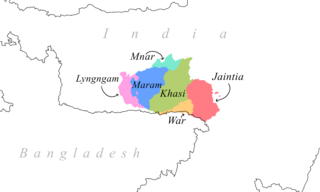
The Austroasiatic languages are a large language family spoken throughout Mainland Southeast Asia, South Asia and East Asia. These languages are natively spoken by the majority of the population in Vietnam and Cambodia, and by minority populations scattered throughout parts of Thailand, Laos, India, Myanmar, Malaysia, Bangladesh, Nepal, and southern China. Approximately 117 million people speak an Austroasiatic language, of which more than two-thirds are Vietnamese speakers. Of the Austroasiatic languages, only Vietnamese, Khmer, and Mon have lengthy, established presences in the historical record. Only two are presently considered to be the national languages of sovereign states: Vietnamese in Vietnam, and Khmer in Cambodia. The Mon language is a recognized indigenous language in Myanmar and Thailand, while the Wa language is a "recognized national language" in the de facto autonomous Wa State within Myanmar. Santali is one of the 22 scheduled languages of India. The remainder of the family's languages are spoken by minority groups and have no official status.

The Nicobarese languages or Nicobaric languages, form an isolated group of about half a dozen closely related Austroasiatic languages, spoken by most of the inhabitants of the Nicobar Islands of India. They have a total of about 30,000 speakers. Most Nicobarese speakers speak the Car language. Paul Sidwell (2015:179) considers the Nicobarese languages to subgroup with Aslian.

The fifteen Katuic languages form a branch of the Austroasiatic languages spoken by about 1.5 million people in Southeast Asia. People who speak Katuic languages are called the Katuic peoples. Paul Sidwell is the leading specialist on the Katuic languages. He notes that Austroasiatic/Mon–Khmer languages are lexically more similar to Katuic and Bahnaric the closer they are geographically. He says this geographic similarity is independent of which branch of the family each language belongs to. He also says Katuic and Bahnaric do not have any shared innovations, so they do not form a single branch of the Austroasiatic family, but form separate branches.

The Bahnaric languages are a group of about thirty Austroasiatic languages spoken by about 700,000 people in Vietnam, Cambodia, and Laos. Paul Sidwell notes that Austroasiatic/Mon–Khmer languages are lexically more similar to Bahnaric and Katuic languages the closer they are geographically, independently of which branch of the family they belong to, but that Bahnaric and Katuic do not have any shared innovations that would suggest that together they form a branch of the Austroasiatic family, rather forming separate branches.

The Pearic languages are a group of endangered languages of the Eastern Mon–Khmer branch of the Austroasiatic language family, spoken by Pear people living in western Cambodia and eastern Thailand.

The Khasic or Khasian languages are a family of Austroasiatic languages native to the Shillong Plateau and spoken by the Khasi, Pnar and other related ethnic groups. Most of them reside in the northeastern Indian state of Meghalaya where Khasi speakers form a plurality of the population. Smaller Khasic-speaking pockets are found in Assam, Manipur, Mizoram and Sylhet Division of Bangladesh.

The Palaungic or Palaung–Wa languages are a group of nearly 30 Austroasiatic languages, with scholars disagreeing on exactly which languages to include in the classification. They are spoken in scattered pockets across an inland region of Southeast Asia, centered on the borders between Myanmar, Thailand, Laos, Vietnam, and China.
The Khmuic languages are a branch of the Austroasiatic languages spoken mostly in northern Laos, as well as in neighboring northern Vietnam and southern Yunnan, China. Khmu is the only widely spoken language in the group.
The Pakanic languages constitute a branch of two Austroasiatic languages, Bolyu and Bugan. They are spoken in Guangxi and Yunnan provinces of southern China. Mang was formerly included, but is now considered by Paul Sidwell to form its own separate branch within Austroasiatic.
The Kenyah languages are a group of half a dozen or so closely related languages spoken by the Kenyah peoples of Borneo. They are:

Pnar, also known as Jaiñtia is an Austroasiatic language spoken in India and Bangladesh.
Proto-Austroasiatic is the reconstructed ancestor of the Austroasiatic languages. Proto-Mon–Khmer has been reconstructed in Harry L. Shorto's Mon–Khmer Comparative Dictionary, while a new Proto-Austroasiatic reconstruction is currently being undertaken by Paul Sidwell.
There have been various classification schemes for Southeast Asian languages.
Katu, or Low Katu, is a Katuic language of eastern Laos and central Vietnam.

Sapuan is a Mon–Khmer language spoken in the single village of Ban Sapuan, located approximately 40 km north of Attapeu. Jacq and Sidwell (1999) provide a short grammar. Sidwell (2003) reports a population of just under 1,000. Chazée (1999:93) gives a lower estimate of 480.
Phuong, or High Katu, is a Katuic language (Mon-Khmer) of Vietnam.
Jru' is a Mon–Khmer language of the Bahnaric branch spoken in southern Laos. It is also known as "Loven", "Laven" or "Boloven" from the Laotian exonym Laven or Loven, which is derived from the Khmer name for the Boloven Plateau. The Jru' people engage in coffee and cardamom cultivation, as well as other agricultural activities.
The Angkuic languages are spoken in Yunnan province, China and Shan State, Burma.
The Proto-Khmeric language is the reconstructed proto-language of the Khmeric languages. It has been reconstructed by Sidwell & Rau (2015), whose reconstruction is based on the sound laws provided in Ferlus (1992). It is agreed by most scholars that this language was phased out by 300 CE.
Proto-Palaungic is the reconstructed proto-language of the Palaungic languages of mainland Southeast Asia.






